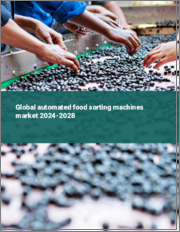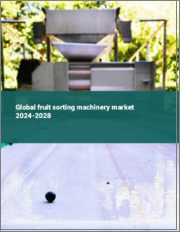
|
시장보고서
상품코드
1620573
선별기 및 등급 분류기 시장 기회, 성장 촉진요인, 산업 동향 분석 및 예측(2024-2032년)Sorting and Grading Machines Market Opportunity, Growth Drivers, Industry Trend Analysis, and Forecast 2024 - 2032 |
||||||
세계 선별기 및 등급 분류기 시장은 2023년 44억 달러로 평가되었고, 2024-2032년간 연평균 5.6%의 성장률을 보일 것으로 예상됩니다. 이러한 성장은 소비자의 라이프 스타일과 취향의 변화로 인해 가공 및 포장 식품에 대한 수요가 증가하고 있는 것이 주요 요인으로 작용하고 있습니다. 도시 지역에서는 중산층이 확대됨에 따라 조리된 제품이나 포장된 제품을 포함한 편리한 식사 옵션에 대한 선호도가 높아지고 있습니다. 이러한 변화는 식품 산업의 생산량 증가로 이어졌고, 일관된 품질을 유지하면서 대량의 식품을 관리할 수 있는 효율적이고 정밀한 선별 및 등급 분류 시스템이 절실하게 요구되고 있습니다. 북미, 유럽, 아시아태평양 등 주요 지역에서 식품 안전 및 품질에 대한 규제가 강화됨에 따라 첨단 선별기 및 등급 분류기에 대한 관심이 높아지고 있습니다.
제조업체들은 이러한 엄격한 기준을 준수하기 위해 노력하고 있으며, 이에 따라 혁신적인 선별 솔루션에 대한 수요가 증가하고 있습니다. 이러한 첨단 선별기는 광학 센서, 머신 비전, 인공지능(AI) 등 첨단 기술을 사용하여 식품의 결함, 오염, 불일치를 정확하게 식별합니다. 이러한 기술을 통해 생산자는 식품의 안전성을 높이고, 생산 라인의 초기 단계에서 불량품을 효과적으로 선별하여 폐기물을 최소화할 수 있습니다. 기술 부문별로는 카메라 및 비전 시스템 부문이 2023년 약 16억 달러로 평가되었고, 2032년까지 5.8%의 연평균 복합 성장률(CAGR)을 나타낼 전망입니다. 이러한 시스템은 농업 및 식품 가공을 포함한 여러 산업에서 정확성, 효율성 및 품질 관리를 강화하는 데 매우 중요합니다.
첨단 이미지 기술을 활용하여 이 시스템은 실시간 시각 데이터를 수집하여 기계가 크기, 형태, 색상, 질감, 결함의 차이를 고속으로 식별할 수 있도록 합니다. 광학 센서와 AI의 통합을 통해 이러한 시스템은 기존의 수동 분류 방법보다 더 정확하게 제품과 재료를 분류 할 수 있습니다. 유통 채널의 경우, 직접 판매 부문은 2023년 시장 점유율의 약 62.3%를 차지하며 2032년까지 연평균 5.4%의 성장률을 보일 것으로 예상됩니다. 반대로 대리점이나 딜러와 같은 중개자를 통해 장비를 판매하는 간접 판매 부문은 현지 제조거점이 제한된 지역에서 널리 퍼져 있습니다. 이 전략을 통해 기업은 제3자 파트너의 전문 지식과 네트워크를 활용할 수 있으며, 더 넓은 고객층에 쉽게 접근할 수 있습니다.
| 시장 범위 | |
|---|---|
| 시작 연도 | 2023년 |
| 예측 연도 | 2024-2032년 |
| 시작 금액 | 44억 달러 |
| 예상 금액 | 70억 달러 |
| CAGR | 5.6% |
아시아태평양의 선별기 및 등급 분류기 시장은 2023년 18억 달러를 넘어설 것으로 예상되며, 2032년까지 연평균 6%의 성장률을 나타낼 것으로 예상됩니다. 이러한 성장은 급속한 산업 발전, 농업 생산량 증가, 가공 식품에 대한 수요 증가에 힘입은 것입니다. 이 지역의 기술 발전으로 다양한 부문에서 자동 선별 솔루션이 널리 채택되어 제품 품질을 개선하고 다양한 농업 환경에서 폐기물을 최소화하고 있습니다.
목차
제1장 조사 방법과 조사 범위
제2장 주요 요약
제3장 산업 인사이트
- 생태계 분석
- 밸류체인에 영향을 미치는 요인
- 이익률 분석
- 변혁
- 향후 전망
- 제조업체
- 유통업체
- 소매업체
- 영향요인
- 성장 촉진요인
- 자동화와 기술 진보
- 가공·포장 식품에 대한 수요 증가
- 지속가능성과 폐기물 관리에의 임해
- 산업의 잠재적 리스크와 과제
- 높은 초기 비용
- 복잡한 유지보수·운영 과제
- 성장 촉진요인
- 잠재 성장력 분석
- 규제 상황
- 가격 분석
- 기술 개요
- Porter's Five Forces 분석
- PESTEL 분석
제4장 경쟁 구도
- 서론
- 기업 점유율 분석
- 경쟁 포지셔닝 매트릭스
- 전략 전망 매트릭스
제5장 시장 추정·예측 : 기술별, 2021-2032년
- 주요 동향
- 카메라 비전 시스템
- 근적외 시스템(NIR)
- X선선별기
- 기계식 선별기
- 레이저 선별기
- 기타
제6장 시장 추정·예측 : 기계 용량별, 2021-2032년
- 주요 동향
- 소형(2톤/시 이하)
- 중형(2-5톤/시)
- 대형(5톤/시 이상)
제7장 시장 추정·예측, 최종 용도별, 2021-2032년
- 주요 동향
- 중량 선별기
- 형태 선별기
- 디스크 선별기
- 실린더 선별기
- 진동 스크린 선별기
- 사이즈 선별기
- 드럼 선별기
- 롤러 선별기
- 벨트 선별기
- 기타(쉐이커 테이블 등)
- 컬러 선별기
- 광학식 선별기
- 카메라식 선별기
- 등급 선별기
- X선선별기
- 근적외(NIR) 선별기
- 결함 선별기
- 재료 감지 선별기
- 특수 선별기&등급 선별기
- 기타(음향 선별기, 밀도 선별기, 중력 선별기 등)
제8장 시장 추정·예측 : 용도별, 2021-2032년
- 주요 동향
- 농업
- 식품 및 음료
- 광업·광물
- 재활용
- 의약품
- 기타(섬유, 목재 등)
제9장 시장 추정·예측 : 유통 채널별 2021-2032년
- 주요 동향
- 직접 판매
- 간접 판매
제10장 시장, 추정·예측, 지역별, 2021-2032년
- 주요 동향
- 북미
- 미국
- 캐나다
- 유럽
- 독일
- 영국
- 프랑스
- 이탈리아
- 스페인
- 아시아태평양
- 중국
- 인도
- 일본
- 한국
- 호주
- 라틴아메리카
- 브라질
- 멕시코
- 중동 및 아프리카
- 사우디아라비아
- 아랍에미리트(UAE)
- 남아프리카공화국
제11장 기업 개요
- Advanced Sorting Machines S.r.l.
- BINDER
- Buhler AG
- Cimbria A/S
- Compac Sorting Equipment Ltd.
- Daewon GSI Co., Ltd.
- FOSS Analytical A/S
- GREEFA
- Key Technology, Inc.
- Meyer Optoelectronic Technology Inc.
- Newtec A/S
- Raytec Vision S.p.A.
- Satake Corporation
- Sesotec GmbH
- TOMRA Systems ASA
The Global Sorting And Grading Machines Market was valued at USD 4.4 billion in 2023 and is expected to experience a CAGR of 5.6% from 2024 to 2032. This growth is largely attributed to the increasing demand for processed and packaged foods, driven by shifting consumer lifestyles and preferences. As urban areas see an expanding middle class, there is a growing inclination toward convenient meal options, including ready-to-eat and pre-packaged products. Consequently, this shift has led to heightened production volumes in the food industry, creating a pressing need for efficient and precise sorting and grading systems that can manage larger food quantities while maintaining consistent quality. The tightening of food safety and quality regulations on a global scale-especially in key regions such as North America, Europe, and Asia Pacific intensified the focus on advanced sorting and grading machines.
Manufacturers are under pressure to comply with these stringent standards, resulting in increased demand for innovative sorting solutions. These sophisticated machines employ cutting-edge technologies like optical sensors, machine vision, and artificial intelligence (AI) to accurately identify defects, contamination, and inconsistencies in food products. By incorporating such technologies, producers can enhance food safety and minimize waste by effectively sorting out subpar items early in the production line. In terms of technological segments, the camera and vision systems category was valued at approximately USD 1.6 billion in 2023, with a projected CAGR of 5.8% through 2032. These systems are crucial to enhance accuracy, efficiency, and quality control across multiple industries, including agriculture and food processing.
Utilizing advanced imaging technologies, these systems capture real-time visual data, allowing machines to discern differences in size, shape, color, texture, and defects at high speeds. The integration of optical sensors and AI empowers these systems to categorize products and materials more accurately than traditional manual sorting methods. When it comes to distribution channels, the direct sales segment represented roughly 62.3% of the market share in 2023 and is projected to grow at a CAGR of 5.4% until 2032. Conversely, the indirect sales segment, which involves selling equipment through intermediaries like distributors and dealers, is prevalent in areas with limited local manufacturing presence. This strategy enables companies to leverage the expertise and networks of third-party partners, facilitating access to a broader customer base.
| Market Scope | |
|---|---|
| Start Year | 2023 |
| Forecast Year | 2024-2032 |
| Start Value | $4.4 Billion |
| Forecast Value | $7 Billion |
| CAGR | 5.6% |
The Asia Pacific market for sorting and grading machines exceeded USD 1.8 billion in 2023, with an expected CAGR of 6% through 2032. This growth is propelled by rapid industrial development, increased agricultural output, and a rising demand for processed food. Technological advancements in the region have led to the widespread adoption of automated sorting solutions across various sectors, enhancing product quality and minimizing waste in diverse agricultural landscapes
Table of Contents
Chapter 1 Methodology & Scope
- 1.1 Market scope & definition
- 1.2 Base estimates & calculations
- 1.3 Forecast parameters
- 1.4 Data sources
- 1.4.1 Primary
- 1.4.2 Secondary
- 1.4.2.1 Paid sources
- 1.4.2.2 Public sources
Chapter 2 Executive Summary
- 2.1 Industry 360° synopsis, 2021 - 2032
Chapter 3 Industry Insights
- 3.1 Industry ecosystem analysis
- 3.1.1 Factors affecting the value chain
- 3.1.2 Profit margin analysis
- 3.1.3 Disruptions
- 3.1.4 Future outlook
- 3.1.5 Manufacturers
- 3.1.6 Distributors
- 3.1.7 Retailers
- 3.2 Impact forces
- 3.2.1 Growth drivers
- 3.2.1.1 Automation and technological advancements
- 3.2.1.2 Rising demand for processed and packaged foods
- 3.2.1.3 Sustainability and waste management initiatives
- 3.2.2 Industry pitfalls & challenges
- 3.2.2.1 High initial costs
- 3.2.2.2 Complex maintenance and operational challenges
- 3.2.1 Growth drivers
- 3.3 Growth potential analysis
- 3.4 Regulatory landscape
- 3.5 Pricing analysis
- 3.6 Technological overview
- 3.7 Porter's analysis
- 3.8 PESTEL analysis
Chapter 4 Competitive Landscape, 2023
- 4.1 Introduction
- 4.2 Company market share analysis
- 4.3 Competitive positioning matrix
- 4.4 Strategic outlook matrix
Chapter 5 Sorting & Grading Machines Market Estimates & Forecast, By Technology, 2021 - 2032, (USD Billion) (Thousand Units)
- 5.1 Key trends
- 5.2 Camera vision systems
- 5.3 Near-infrared systems (NIR)
- 5.4 X-ray sorting machines
- 5.5 Mechanical sorting machines
- 5.6 Laser sorting machines
- 5.7 Others
Chapter 6 Sorting & Grading Machines Market Estimates & Forecast, By Machine Capacity, 2021 - 2032, (USD Billion) (Thousand Units)
- 6.1 Key trends
- 6.2 Small (up to 2 ton/hour)
- 6.3 Medium (2-5 ton/hour)
- 6.4 Large (above 5 ton/hour)
Chapter 7 Sorting & Grading Machines Market Estimates & Forecast, By End Use, 2021 - 2032, (USD Billion) (Thousand Units)
- 7.1 Key trends
- 7.2 Weight sorters
- 7.3 Shape sorters
- 7.3.1 Disc sorters
- 7.3.2 Cylinder sorters
- 7.3.3 Vibrating screen sorters
- 7.4 Size sorters
- 7.4.1 Drum sorters
- 7.4.2 Roller sorters
- 7.4.3 Belt sorters
- 7.4.4 Others (Shaker tables, etc.)
- 7.5 Color sorters
- 7.5.1 Optical sorters
- 7.5.2 Camera-based sorters
- 7.6 Quality sorters
- 7.6.1 X-ray sorters
- 7.6.2 Near-infrared (NIR) sorters
- 7.7 Defect sorters
- 7.8 Material detects sorters
- 7.9 Specialty Sorter & Graders
- 7.10 Others (Acoustic sorters, density sorters, gravity separators, etc.)
Chapter 8 Sorting & Grading Machines Market Estimates & Forecast, By Application, 2021 - 2032, (USD Billion) (Thousand Units)
- 8.1 Key trends
- 8.2 Agriculture
- 8.3 Food & beverage
- 8.4 Mining & minerals
- 8.5 Recycling
- 8.6 Pharmaceuticals
- 8.7 Others (e.g. textile, timber)
Chapter 9 Sorting & Grading Machines Market Estimates & Forecast, By Distribution Channel, 2021 - 2032, (USD Billion) (Thousand Units)
- 9.1 Key trends
- 9.2 Direct sales
- 9.3 Indirect sales
Chapter 10 Sorting & Grading Machines Market Estimates & Forecast, By Region, 2021 - 2032, (USD Billion) (Thousand Units)
- 10.1 Key trends
- 10.2 North America
- 10.2.1 U.S.
- 10.2.2 Canada
- 10.3 Europe
- 10.3.1 Germany
- 10.3.2 UK
- 10.3.3 France
- 10.3.4 Italy
- 10.3.5 Spain
- 10.4 Asia Pacific
- 10.4.1 China
- 10.4.2 India
- 10.4.3 Japan
- 10.4.4 South Korea
- 10.4.5 Australia
- 10.5 Latin America
- 10.5.1 Brazil
- 10.5.2 Mexico
- 10.6 MEA
- 10.6.1 Saudi Arabia
- 10.6.2 UAE
- 10.6.3 South Africa
Chapter 11 Company Profiles
- 11.1 Advanced Sorting Machines S.r.l.
- 11.2 BINDER
- 11.3 Buhler AG
- 11.4 Cimbria A/S
- 11.5 Compac Sorting Equipment Ltd.
- 11.6 Daewon GSI Co., Ltd.
- 11.7 FOSS Analytical A/S
- 11.8 GREEFA
- 11.9 Key Technology, Inc.
- 11.10 Meyer Optoelectronic Technology Inc.
- 11.11 Newtec A/S
- 11.12 Raytec Vision S.p.A.
- 11.13 Satake Corporation
- 11.14 Sesotec GmbH
- 11.15 TOMRA Systems ASA



















